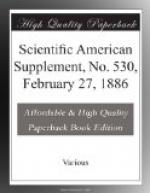Alkali. Bleach
Acid Machine
(chemic).
Washes.
/ Saturate.
(1) <
\ Steam.
/
(2) Continuous
|
(chemic)
|
machine
|
(or keir if
(2)
< for yarns,
|
etc.).
|
(2a) Machine or
\
pit sour.
(3)
Wash up for
finishing.
ORDINARY SYSTEM.
Alkali. Bleach.
Acid Machine
Washes.
(1) Lime stew.
(1) Wash.
(2)
Sour. (2) "
(3) Gray bowk
(3) "
(soda ash).
(4)I Chemic.
(4) "
(5)
Sour. (5) "
(6) White bowk.
(6) "
(7)II Chemic.
(7) "
(8)
Sour. (8) "
It will be understood that 2 and 2a are merged into a single process by using the “continuous” machine. Of course, it will be understood that the cloth has in each case to be cleansed from size and loose impurities. The “Mather-Thompson” Company claim that their system takes twelve hours in the case of “market” or “white” bleaching. They reckon eight hours for the steaming process and four for bleaching and washing. This has to be compared with the old system, which generally takes forty hours, made up as follows: 8 treatments with reagents and the necessary washings, the former taking four hours and the latter one hour each.
The “Mather-Thompson” system has created considerable commotion in English bleaching circles. It is generally considered that the bleachers throughout the whole country will be compelled to adopt it, so great is the saving in time and cost. In commencing a bleachery, the cost of plant by this system is, I understand, less than by the old processes.—Textile Colorist.
* * * * *
INSTRUMENTS FOR DRAWING CURVES.
By Prof. C.W. MacCord, Sc.D.
I. THE HYPERBOLA.
We are free to express the opinion at the outset, that for various reasons the draughtsman is likely to gain very little advantage by the use of mechanical devices for describing mathematical curves by continuous motion. Such instruments are as a rule not only complicated and expensive, but cumbersome and difficult of adjustment. It may be suggested, per contra, that these objections do not apply to the familiar combination of two pins and a string, for tracing the “gardener’s ellipse.” But we question the propriety of classing a string among strictly mechanical devices; it has its uses, to be sure, but in respect to perfect flexibility and inextensibility it cannot be relied on when rigid accuracy is required in drawing any of the conic sections.




